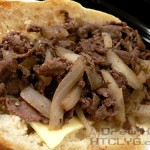Last week I saw a screening of a Fresh, new documentary by Ana Sofia Joanes. If you follow Michael Pollan the way I do, you already know most of the issues covered, but it’s nice to hear about it from the people actually involved.
The subject is the way food is produced in the U.S., from “conventional” agriculture — meaning large-scale industrial monoculture operations — to more traditional mixed-use farming, to urban gardens in greenhouses on what used to be vacant lots.
Independence = happiness
There is no narration, so the story is entirely left to the farmers being interviewed. But one unavoidable conclusion is that the people using conventional techniques feel trapped by the system, with little control over their lives.
One couple owns a chicken farm. They never name the company they sell the chickens to, except to call them “the company”. What they do say is that they had to sign a 7-year contract stating that they will:
- buy all chicks from the company
- buy all feed from the company
- sell all full-grown chickens to the company
- maintain their own facilities at their cost while making upgrades as demanded by the company
And their profit is based on how many pounds of feed it takes to grow each chicken to four pounds. If they didn’t agree to the terms, the next day they would have no new chicks, and there are no other suppliers available in their area. Industrial agriculture has been increasing scale, specialization and concentration for decades, and has now reached the point that two or three companies can dictate terms of the entire process, “from seed to plate” as Pollan says.
As you watch this couple, you’ll notice the wife does most of the talking. And the husband seems to look more and more unhappy, as though he’s just realizing, as he hears his wife spell it out, how little control they have over their own success.
In contrast, the farmers who have opted out of the industrial process are universally happy with their lives. They love what they do, and look forward to sharing what they produce.
One hog farmer recounts getting scratched by a tusk when he was running a confinement-style operation. After three weeks, he nearly lost his leg to the antibiotic-resistant staff infection he contracted. Only a new, experimental drug worked. He finally listened to the voice in the back of his head that had been telling him this wasn’t the right way to do things.
He slaughtered his entire herd and started over from scratch, without using antibiotics. And because he doesn’t confine the hogs in close quarters, he doesn’t have the disease problems that would require them.
It’s not all about the bottom line
The startling thing, if you haven’t heard it before, is that the mixed-use operations actually yield many times as much money per acre as the monoculture operations. Why, then, do companies keep moving in that direction? Don’t corporations always follow the bottom line?
In this case, it’s a matter of control. The goal of industrialization has always been consistency. And the surest way to eliminate variability is to eliminate people from the process as much as possible. Financial projections work better when you can specify what your inputs will be, and you know the yield, so you can calculate the output precisely.
Traditional farming requires a knowledgeable farmer, which we used to have and value in this country. Instead, industry prefers “workers” who can follow directions.
So why do we eat it?
The food coming out of industrial agriculture isn’t as tasty, isn’t as nutritious, and even frequently costs more than cooking from scratch. So why do we eat it?
That’s answered in the first five minutes of the movie, when a farmer tells about his college roommate who came from Pakistan. He said that Americans are only terrified of one thing: Inconvenience.











